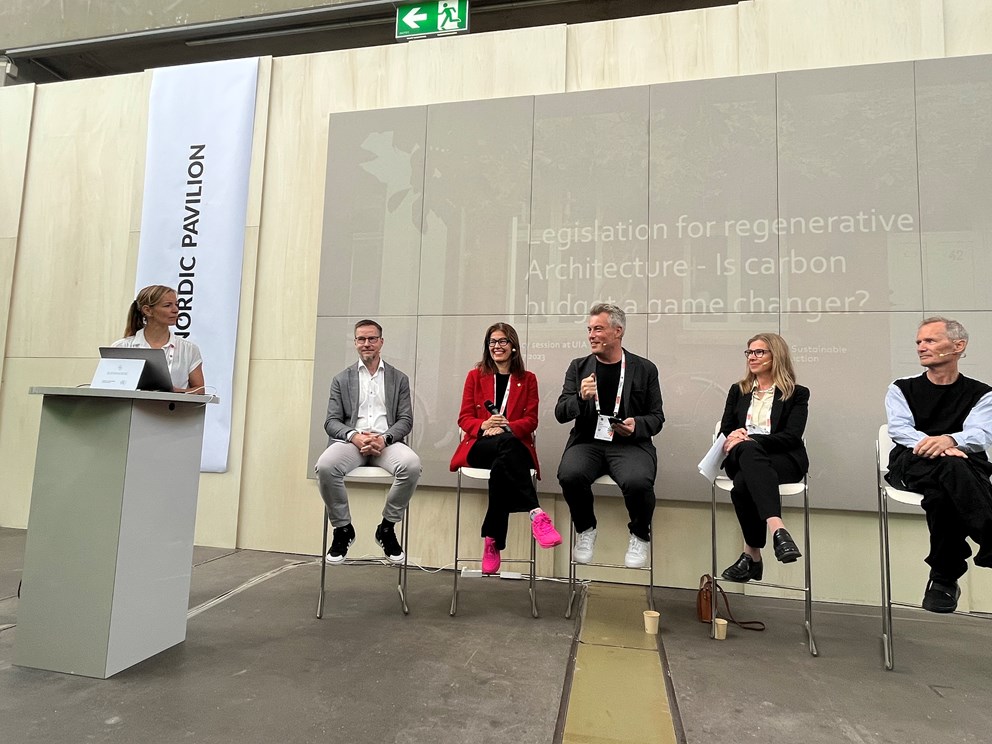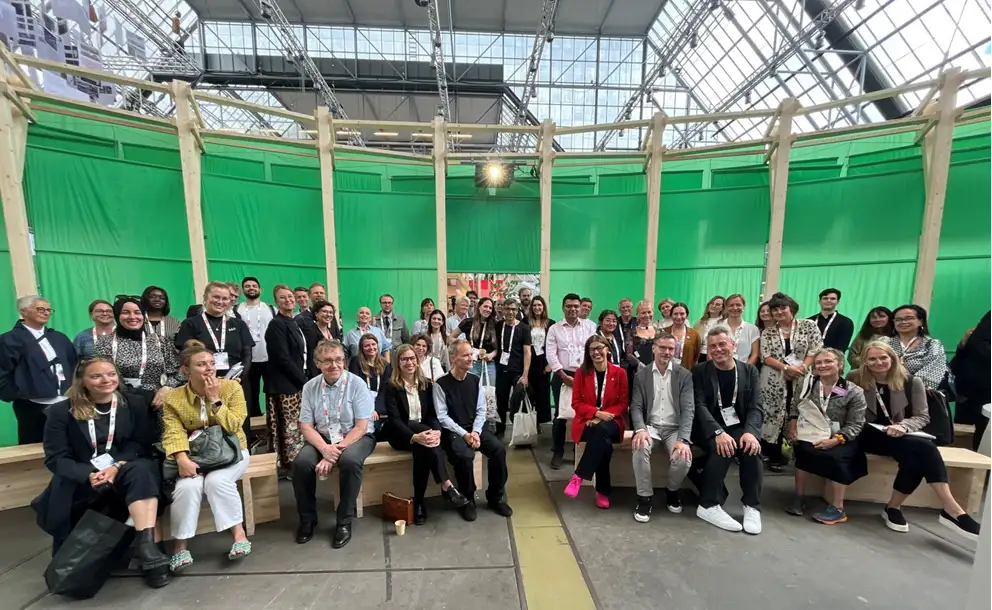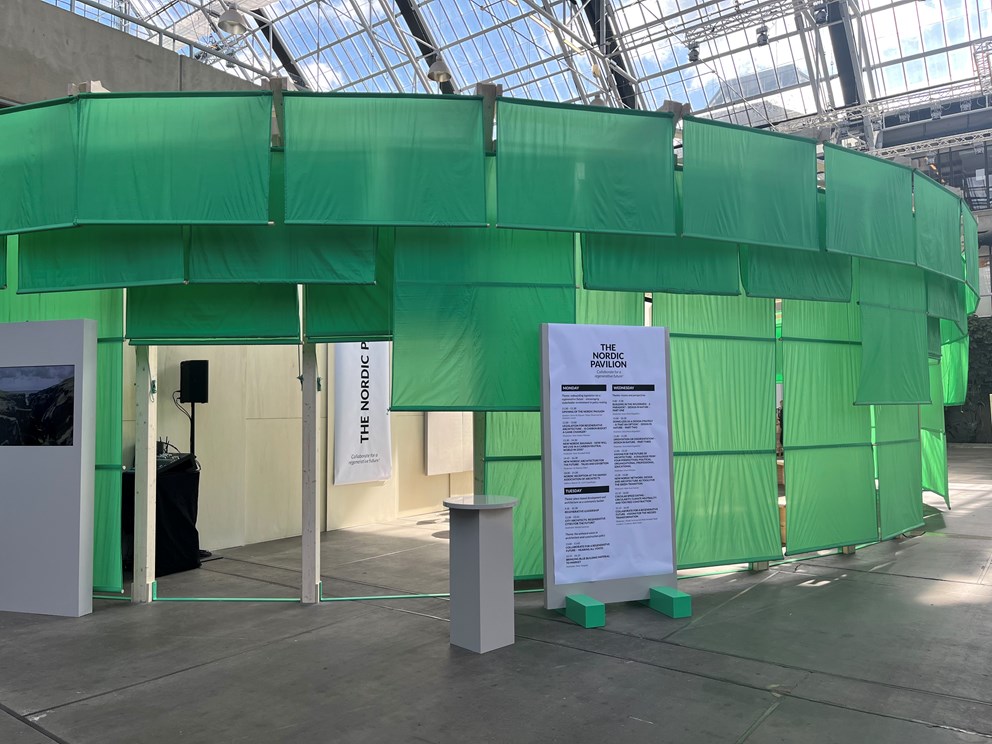If we want to reach the green climate goals, the construction sector has to transition – and fast. Therefore, regulatory tools as measuring the climate impact of buildings and setting limit values for their carbon emission are introduced across Nordic countries and beyond.
But will carbon budgets in construction change the way we build today? How do architects experience the new legislation on carbon emission of buildings, and how can architects contribute to the move towards sustainability?
In our policy session, Professor at Aalto University Matti Kuittinen; President of the Danish Association of Architects Johnny Svendborg; Director of Architects Sweden Tobias Olsson; National Architect at the Swedish National Board of Housing Helena Bjarnegård; and President of the Architects’ Council of Europe Ruth Schagemann gathered to answer these questions in the company of over 40 interested stakeholders from across the globe. Underneath you get the highlights from the session.

How will we reach a lower carbon impact in construction?
Emphasis on the architectural design
“The way we design buildings has to change to stay below limit values of carbon emission and to execute in a low carbon manor. To avoid that other stakeholders in the building process are too limited in unforeseen changes during the construction phase, more resources and time for design has to happen early in the architect’s design process,” Matti Kuittinen, Professor at Aalto University.
Best practice examples need to become the new normal
“Across Europe there are many best practice examples of low carbon construction and more sustainable methods. They combine a big hub of knowledge that needs to be spread in order to become the new normal,” Ruth Schagemann, President of the Architects’ Council of Europe.
Building upon the existing and the role of beauty
“In Sweden, we see it as a new journey for the architect. Our role is changing to the ancient architectural role – to build upon the existing. By asking what the need for a construction is and by assessing whether a new building is even necessary, the existing buildings may cover our needs. For this, we are going to see a shift in aesthetics where we need to safeguard the role of beauty. At the same time, legislation will steer the design profoundly,” Tobias Olsson, Director of Architects Sweden.
Understanding the shift
“We are in the midst of the transformation process. On a European scale it started with the green deal, and now we are trying to create a new architectural language which will define the decade we are working in now,” Ruth Schagemann, President of the Architects’ Council of Europe.
Working with legislation – not against it
“What happens when we start to talk about a need for new legislation? Innovation and funding thrive, and climate goals are made. In this process, architects need to be in the middle of the table, working creatively and translating legislation into physical elements. The different sector need to work together, and we need to find synergies in different legislation as these are the base line to get everyone on the same page,” Helena Bjarnegård, National Architect at the Swedish National Board of Housing.
A holistic approach
“Conversation about carbon budgets need to happen on a Nordic, European and International level. And we need to take a holistic approach with new aesthetics, where we start with considerations of climate, material and context when we begin construction projects,” Johnny Svendborg, President of the Danish Association of Architects.

What are the challenges in the newest legislation, and how can architects contribute to solving them?
Expanding the compass of life cycle assessments
“A role for the architects can be to move carbon count from construction phases to renovation and refurbishment projects as well as these markets are larger than new construction projects. In addition, we should expand the focus on material consumption and resources of buildings to calculating the material weight of a building and its level of circularity. In this way, how many percentages of the materials in a building is reused, and happens even its effect on biodiversity, could be incorporated into the life cycle assessments of buildings,” Matti Kuittinen, Professor at Aalto University.
Are we changing culture or legislation?
“Is it the culture or legislation that needs to change? It is both. Our limit values for carbon emission from buildings need to be more ambitious. Architects are already embracing the transition and new way of working. But we need more tools as the Reduction Roadmap and the Doughnut for Urban Development,” Johnny Svendborg, President of the Danish Association of Architects.
Architects as agents of change
“Architects wants to be agents of change and see change happening in reality. Therefore, we need to equip, empower and enable architects and designers and train them in redesigning properties with a low carbon footprint,” Helena Bjarnegård, National Architect at the Swedish National Board of Housing.
Reconsidering the client
“As the majority of the existing building stock is owned by private citizens, we need to reconsider the client. The civil society has to make changes and become part of the movement towards sustainability. Here architects need to highlight what the holistic approach to architecture means and explain the value they create for the living environment,” Ruth Schagemann, President of the Architects’ Council of Europe.
Understanding the legislative framework
“The European institutions (the EU commission, council and parliament) cannot make changes in culture but make recommendations to member states. Therefore, the framework is a combination of cultural recommendations on one side and hard energy demands on the other. The challenge is to develop a framework that enables architects to execute as best as possible on national scale. However, in the new EPBD (Energy Performance of Buildings Directive), which is currently under negotiations, we are taking a more wholesome approach and are discussing entire neighbourhoods instead of separate buildings. At the same time, the existing building stock is included – and this will have a huge impact,” Ruth Schagemann, President of the Architects’ Council of Europe.
